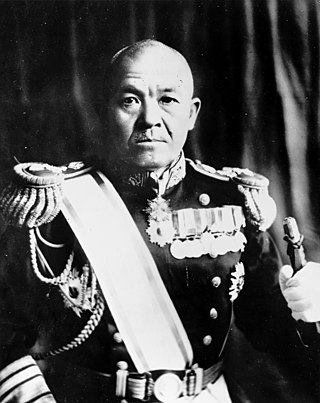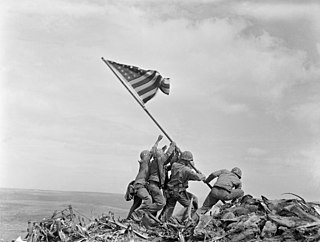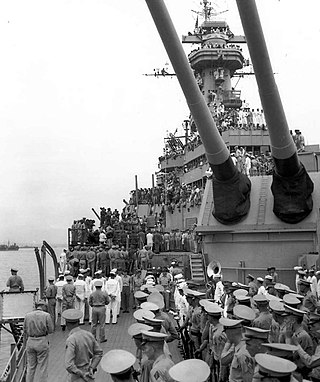Related Research Articles

A battle is an occurrence of combat in warfare between opposing military units of any number or size. A war usually consists of multiple battles. In general, a battle is a military engagement that is well defined in duration, area, and force commitment. An engagement with only limited commitment between the forces and without decisive results is sometimes called a skirmish.

Isoroku Yamamoto was a Marshal Admiral of the Imperial Japanese Navy (IJN) and the commander-in-chief of the Combined Fleet during World War II.

Chūichi Nagumo was an admiral in the Imperial Japanese Navy (IJN) during World War II. Nagumo led Japan's main carrier battle group, the Kido Butai, in the attack on Pearl Harbor, the Indian Ocean raid and the Battle of Midway. He committed suicide during the Battle of Saipan.

The Pacific War, sometimes called the Asia–Pacific War or the Pacific Theater, was the theater of World War II that was fought in eastern Asia, the Pacific Ocean, the Indian Ocean, and Oceania. It was geographically the largest theater of the war, including the vast Pacific Ocean theater, the South West Pacific theater, the Second Sino-Japanese War, and the Soviet–Japanese War.

Vice Admiral Robert Lee Ghormley was an admiral in the United States Navy who served as Commander, South Pacific Area during World War II. Ghormley was long considered to be an ineffective leader–overly cautious, pessimistic, and even defeatist–but recent scholarship has argued that while he may not have been an inspiring leader, he performed well enough under difficult circumstances.
During World War II, at the beginning of the Pacific War in December 1941, the Imperial Japanese Navy (IJN) was the third most powerful navy in the world, and the naval air service was one of the most potent air forces in the world. During the first six months of the war, the IJN enjoyed spectacular success inflicting heavy defeats on Allied forces, being undefeated in every battle. The attack on Pearl Harbor crippled the battleships of the US Pacific Fleet, while Allied navies were devastated during Japan's conquest of Southeast Asia. Japanese Navy aircraft operating from land bases were also responsible for the sinkings of HMS Prince of Wales and HMS Repulse which was the first time that capital ships were sunk by aerial attack while underway. In April 1942, the Indian Ocean raid drove the Royal Navy from South East Asia. After these successes, the Japanese now concentrated on the elimination and neutralization of strategic points from where the Allies could launch counteroffensives against Japan's conquests. However, at Coral Sea the Japanese were forced to abandon their attempts to isolate Australia while the defeat at Midway saw them forced on the defensive. The campaign in the Solomon Islands, in which the Japanese lost the war of attrition, was the most decisive; they had failed to commit enough forces in sufficient time.
Principles of war are rules and guidelines that represent truths in the practice of war and military operations.
Annihilation is a military strategy in which an attacking army seeks to entirely destroy the military capacity of the opposing army. This strategy can be executed in a single planned pivotal battle, called a "battle of annihilation". A successful battle of annihilation is accomplished through the use of tactical surprise, application of overwhelming force at a key point, or other tactics performed immediately before or during the battle.
Deep operation, also known as Soviet Deep Battle, was a military theory developed by the Soviet Union for its armed forces during the 1920s and 1930s. It was a tenet that emphasized destroying, suppressing or disorganizing enemy forces not only at the line of contact but also throughout the depth of the battlefield.

The Decisive Battle Doctrine was a naval strategy adopted by the Imperial Japanese Navy prior to the Second World War. The theory was derived from the writings of American naval historian Alfred Thayer Mahan. In the Decisive Battle Doctrine the Japanese navy would win a war by fighting and winning a single, decisive naval action. The idea gained broad acceptance following the Russo-Japanese War, where a well-trained, smaller Japanese naval force gained a decisive victory in the Sea of Japan at the Battle of Tsushima, defeating the Imperial Russian Navy of their rival the Russian Empire, a western naval power. Operational plans thereafter were influenced by the effective naval gunnery Japan demonstrated at Tsushima.
A strategic victory is a victory that brings long-term advantage to the victor and disturbs the enemy's ability to wage a war. When historians speak of a victory in general, they usually refer to a strategic victory. Usually it comes together with a tactical victory on the field that allowed to further progress the objectives of the campaign, but it is also possible for a tactical defeat to be considered a strategic victory because it managed to achieve other goals.
An offensive is a military operation that seeks through an aggressive projection of armed forces to occupy or recapture territory, gain an objective or achieve some larger strategic, operational, or tactical goal. Another term for an offensive often used by the media is "invasion", or the more general "attack". An offensive is a conduct of combat operations that seek to achieve only some of the objectives of the strategy being pursued in the theatre as a whole. Commonly an offensive is carried out by one or more divisions, numbering between 10 and 30,000 troops as part of a combined arms manoeuvre.
In military tactics, a tactical victory may refer to a victory that results in the completion of a tactical objective as part of an operation or a result in which the losses of the "defeated" outweigh those of the "victor" although the victorious force failed to meet its original objectives.
The 1st Fleet was the main battleship fleet of the Imperial Japanese Navy.

The United States Navy grew rapidly during its involvement in World War II from 1941–45, and played a central role in the Pacific War against Imperial Japan. It also assisted the British Royal Navy in the naval war against Nazi Germany and Fascist Italy. The U.S. Navy grew slowly in the years prior to World War II, due in part to international limitations on naval construction in the 1920s. Battleship production restarted in 1937, commencing with the USS North Carolina. The US Navy was able to add to its fleets during the early years of the war while the US was still neutral, increasing production of vessels both large and small, deploying a navy of nearly 350 major combatant ships by December 1941 and having an equal number under construction.
At the beginning of World War II, the Royal Navy was the strongest navy in the world, with the largest number of warships built and with naval bases across the globe. It had over 15 battleships and battlecruisers, 7 aircraft carriers, 66 cruisers, 164 destroyers and 66 submarines. With a massive merchant navy, about a third of the world total, it also dominated shipping. The Royal Navy fought in every theatre from the Atlantic, Mediterranean, freezing Northern routes to Russia and the Pacific ocean.
This article discusses aircraft carrier operations during World War II.
Naval historians such as Evan Mawdsley, Richard Overy, and Craig Symonds concluded that World War II's decisive victories on land could not have been won without decisive victories at sea. Naval battles to keep shipping lanes open for combatant's movement of troops, guns, ammunition, tanks, warships, aircraft, raw materials, and food largely determined the outcome of land battles. Without the Allied victory in keeping shipping lanes open during the Battle of the Atlantic, Britain could not have fed her people or withstood Axis offensives in Europe and North Africa. Without Britain's survival and without Allied shipments of food and industrial equipment to the Soviet Union, her military and economic power would likely not have rebounded in time for Russian soldiers to prevail at Stalingrad and Kursk.
Second Operational Phase refers to the invasion strategy detailed in the Greater East Asia War Second Stage Operation Imperial Navy Operation Plan (大東亜戦争第二段作戦帝国海軍作戦計画), presented to the Emperor of Japan, April 1942, by the Imperial General Headquarters. Whereas the objective of the First Phase was to capture resource-rich areas of Southeast Asia needed by the Japanese military, the Imperial Japanese Army, having fully backed the First Operational Phase, was reluctant to assign troops to the Second. The objective of the Second Operational Phase was to threaten the supply line from the United States to Australia by occupying strategic points in eastern New Guinea, New Britain, the Aleutians, Midway, Fiji, and Samoa; occupying these points would also expand Japan's strategic depth. Occupying Hawaii then became a possibility; this, and severance of supply lines between Australia and the United States, offered the hope of early peace negotiations. The territory occupied in the Second Operational Phase could be bartered in exchange for an early end to the war.
References
Notes
- ↑ "Decisive Battle". The Great Soviet Encyclopedia (3rd (1970-1979) ed.). Farmington Hills, Michigan: The Gale Group, Inc. 2010. Retrieved December 10, 2016– via The Free Dictionary.
[Originally], a concept current in the art of war from the 18th to the early 20th century, which was understood to be the armed clash between the main forces of the belligerent sides that decided the course of a war or campaign or that caused a radical turning in the course of military action.
- ↑ Bretnor, Reginald (February 1, 2001). Decisive Warfare: A Study in Military Theory (New ed.). Wildside Press. pp. 49–52. ISBN 9781587152481 . Retrieved December 10, 2016.
- ↑ Gray, p. 11.
- ↑ Goss, pp. 11, 16.
- ↑ Vego, Dr. Milan (2009). "Naval Classical Thinkers and Operational Art". Naval War College: 4. Archived from the original on 2017-06-28. Retrieved December 12, 2016.
{{cite journal}}: Cite journal requires|journal=(help)
Bibliography
- Goss, Thomas J. "Gettysburg's 'Decisive Battle'." Archived 2011-07-18 at the Wayback Machine Military Review (July–August 2004): 11–16.
- Gray, Colin (2002), Defining and Achieving Decisive Victory, DIANE Publishing, ISBN 978-1-4289-1092-8